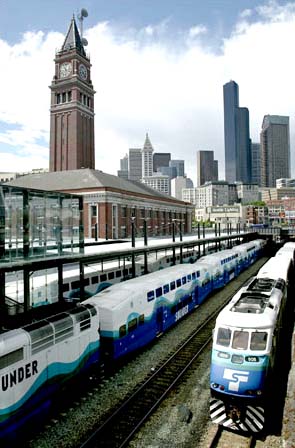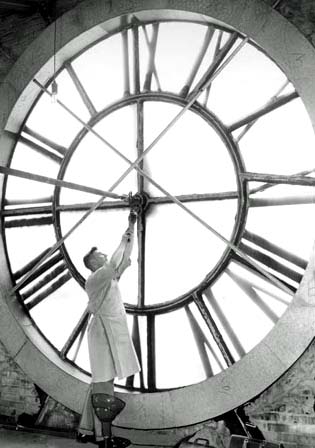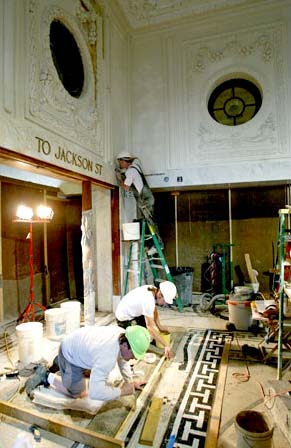 20 June 2005 King Street Station on Track to Return to One-Time Splendor 
King Street Station in Seattle, with its familiar clock
tower, is somewhat of an eyesore today. But it wasn't
always that way.
Seattle Washington USA - For close to half a century, Seattle's skyline was dominated by two towers: Smith Tower and the red brick clock tower of the 1906 King Street Station, an imitation of a famous tower in Piazza San Marco, Venice, Italy.
Inside the station, a grand two-story waiting room sported fluted pilasters, polished marble wainscoting, and elaborate plaster ornamental wall panels of garlands and cornucopias.
The cream-colored ceiling was bordered with plaster medallions. Mosaic tiles covered the floor.
But as the 1950s and 1960s arrived, the railroads that owned the station decided to "modernize" it.
"By today's standards, we think they engaged in destruction," says Lloyd Flem, executive director of the Washington Association of Rail Passengers.

In this 1949 file photo, when train travel was a popular mode of transportation,
a crowd waits in King Street Station for the departure of the Empire Builder.
The ornamental wall plaster was planed down, windows were boarded up, metal doors replaced wood doors. Worst of all, a low, dark, false ceiling was installed.
Outside, microwave antennas were placed on the clock tower. The terra cotta roof was replaced with asphalt composition roofing.
"Why would they remove a terra-cotta roof which lasts for 100 years?" exclaims Peter Watson, project manager for Otak, an architectural firm working on renovating the station with developer Nitze-Stagen.
The state Department of Transportation, using Amtrak and federal money, is leading the effort to undo the damage of the "modernization" and clean up the dreary and long-neglected station.

In a 1957 file photo, an IBM employee works on the face
of the impressive clock.
The redo, which has been talked about for years, coincides with a resurgence of passenger rail service.
The $16.8 million renovation, already under way and planned to be completed by early next year, is just the start on a path to future prominence for the station, officials hope.
The remodel will bring back the 1906 ceiling and other ornamentation and the wood doors. It also will provide new windows, an expanded waiting room, and new ticketing, restroom, and baggage facilities. There will be new heating and ventilation systems, along with earthquake protections.

From left, stonemasons Mike Strickland, Mat Winthal
and, on ladder, Lyle Russell work on replacing tile
in the King Street Station's Compass Room recently.
On the wall above the workers are two cartouches,
large decorative plaques.
Outside, the building will get new canopies and a new roof, terra cotta. The clock will be repaired. The microwave antennae will go. An incompatible 1950s addition on the west side will be removed. The dirty building will be cleaned inside and out, Watson says.
Passengers waiting for trains at the station last week were positive about the renovation.
Rosemary Agostini, a Seattle doctor who planned to study for an exam on the train to Portland, said she had peeked at the original ceiling visible along the edges of the false ceiling.
"I love it when they do renovations," she said. "I think it's really, really good. I've traveled a lot in Europe. They have beautiful stations there. It's nice when people from there traveling here are able to see something that has some character and not just square ugliness."
Marci Robison of Portland gave a thumbs up to the clean-smelling, renovated bathroom. "I was pleasantly surprised," she said.
Decades ago, the nation's freight railroads exited the passenger rail business and didn't see much reason to spend money on passenger terminals such as the King Street Station, which is owned by Burlington Northern Santa Fe Railroad.
"For 60 or 70 years, governments at all levels put virtually all their investments into highways and airports," says Flem.
But he says things turned around when highways became more congested, airports became more of a hassle, and people began traveling more to Japan and Europe, where they saw and experienced a thriving rail service.
"People are tired of driving all the time," says Ron Sheck, urban rail manager for the state Department of Transportation, which is in charge of the King Street Station renovation.
Amtrak's Cascades route between Portland and Seattle was operating one daily train in 1993 with 94,000 passengers a year. The state decided to start spending on rail and added a second daily round trip the next year, nearly doubling ridership to 180,000.
The state has continued to gradually ramp up service, says Kirk Frederickson, rail planning coordinator for the state. It has added trains and also extended service north to Bellingham and Vancouver, B.C. The state of Oregon has extended service from Portland to Eugene.
Last year saw 603,000 passengers on the Eugene to Vancouver, B.C., Cascades service, more than six times what ridership on the Cascades service was in 1993.
The station also serves two Amtrak long-distance routes and Sound Transit's Sounder commuter service.
"The mayor's strategy is for (the King Street Station) to be perhaps the busiest of our three center city intermodal hubs," says Joan McCallion of the city's Department of Transportation. The other two are Colman Dock and Westlake Center.
The Seattle Monorail Project plans to put one of its stations next to King Street Station. The city is hoping that Greyhound will relocate there, says McCallion.
Taxis line up there. A Sound Transit light rail station is a block away. The city would like to explore moving a bike station to the rail station.
In the longer term, the city and others would like to see development on the north parking lot of Qwest Field just southwest of the rail station.
The city and state would also like to see renovation and activity in the vacant top two floors of the King Street Station, once used for railroad office and crew space.
Flem says he'd like to see high-end office space and a good restaurant, as has happened at Portland's restored Union Station.
"Plans are being developed for future use of the property," said Burlington spokesman Gus Melonas, declining to elaborate.
Until the renovation started, the King Street Station was dark, dirty, often mostly empty.
"It just slowly got grubbier and less attractive to the point that, frankly, most rail advocates were a little ashamed of it the last few years compared to the beautiful restoration of Portland Union Station," says Flem.
He's convinced the remodel will attract more passengers.
"It really does make a difference," he says. "People do respond to something that's aesthetically pleasing."
Station Facts
Largest passenger rail station in Northwest.
Amtrak service: Cascades between Eugene, Ore., and Vancouver, B.C., Coast Starlight between Seattle and Los Angeles, Empire Builder between Seattle and Chicago.
Sound Transit Sounder commuter service: Morning and evening rush hours between Seattle and Everett, and between Seattle and Tacoma. Service also to Seahawks and Mariners games.
2004 traffic: More than 628,000 passengers got on or off an Amtrak train at the station, 880,000 passengers got on or off a Sounder train.
Jane Hadley. Back
|




